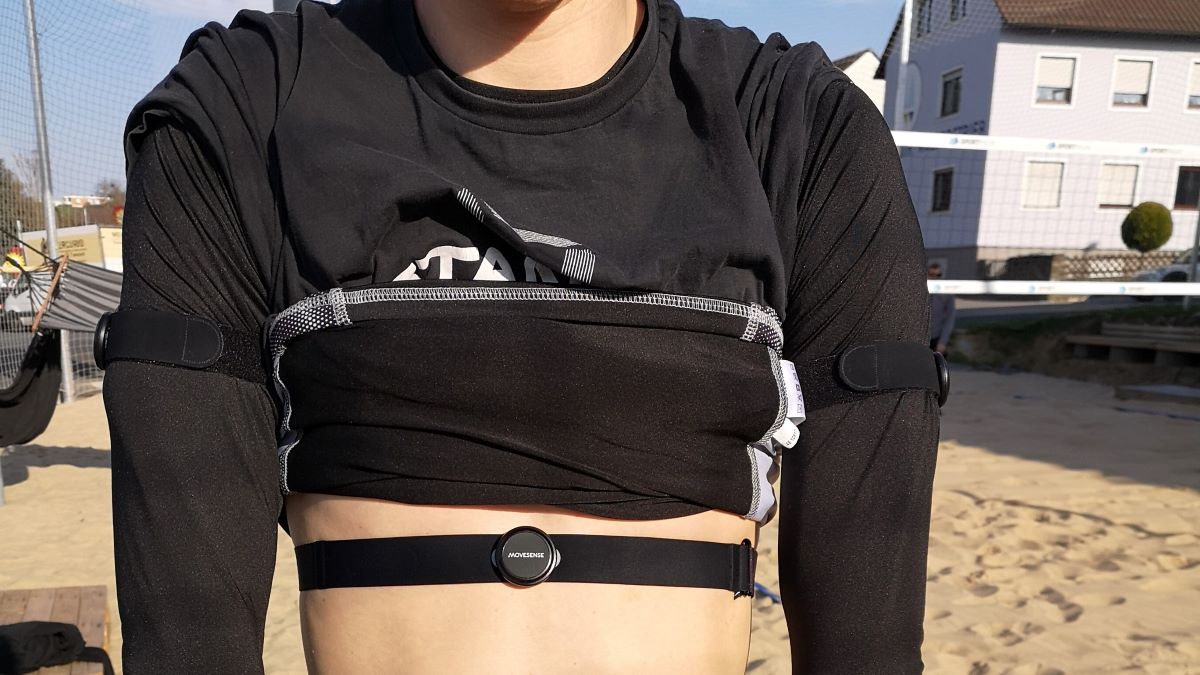Measuring Training Load and Detecting Events in Beach Volleyball with Movesense Sensors

Researchers at the University of Mainz, Germany, have developed a practical and cost-effective system for automatic training load monitoring in beach volleyball, using Movesense Sensor and Kaasa Data Collector. The team presented the project in a poster at the German youth high performance sports symposium in May.
The project started from the needs of the German Volleyball Association (DVV). It aims at better understanding and documenting beach volleyball training and, in particular, the associated training load. It was funded by the Federal Institute of Sports Science of Germany.
Sport-specific training load in beach volleyball
Beach volleyball is characterized by a soft sand court and a two-player team with no substitutes. This sets specific requirements on both player skills and endurance. To control the ball over the whole court, players use sequences of fast movements such as repetitive explosive jumps, short sprints, dives, and frequent shifts in movement direction. The result is a higher individual stress level and load during training and competition in comparison to traditional volleyball.[i]
As with any sport, managing beach volleyball training requires optimization of training volume, intensity, and recovery. To get there, these three components need to be measured.
For measuring recovery, there are already excellent methods based on heart rate variability. Assessing the training load is often more difficult and specific to each sport. In general, it is based on identifying and quantifying relevant events in that cause the load, as well as detecting the overall training intensity and volume.
To solve the need in beach volleyball, Mainz University researchers, Prof. Mark Pfeiffer and Christian Rasche monitored players with Movesense sensors. Each player was wearing three sensors, one at each upper arm and one at the chest. The researchers used Kaasa Data Collector application with synchronized video feed to collect raw data from standardized training sessions, and tagged relevant events with the hot button feature of the app.
From data to insights with advanced mathematics
The data analysis consisted of two steps, event detection and action classification.
Using six channels of data (IMU6, accelerometer + gyroscope) from three sensors, data scientist Dr. Benjamin Groh first crunched the raw data into a format that could be used to detect specific events, e.g., jumps, parallel arm movements, and ball contacts. He then classified the identified events into eight different actions in the game, such as, serves, ball receptions, attacks, and blocks, using different statistical tools, classifiers, and cross-validation.
The current classification accuracy compared to manually annotated events ranges from 75.4% up to 94.7%, depending on the event type. The classification results are very promising, but the team will continue optimizing the algorithms for better distinction of fast action combinations.
The results already allow an in-depth analysis of training characteristics and the associated training load. Coaches can use this to optimize training content and intensity, and actively manage the recovery of athletes from games and training.
Beach volleyball training load app planned for 2022
The next step of the development project is to build the analytics solution into a dedicated mobile app. The app will enable field testing with a larger number of players. Kaasa solution GmbH is working on the app with the target of starting the test phase this summer. They aim to make the new training tool available for athletes and coaches still in 2022.
Several beach volleyball experts participated the project, including Olympic coach and Olympic bronze medalist Jörg Ahmann and pro player and coach Jonas Reinhardt (@jonasjona). Reinhardt was involved in the data collecting phase of the project. He is excited about the benefits of the new tool in daily practice.
— Training load management is very important for me and my team partner. During the main season, there are tournaments and games every week, and we have only little time to recover. We need reliable information and evaluation of daily training to plan and adapt accordingly. We are looking forward to using the new app to help us stay healthy and improve our performance, says Reinhardt.
Prof. Mark Pfeiffer and Christian Rasche are currently preparing the next phase of the project.
— The automatic event detection and classification results are very promising, although we need to fine tune the algorithms to further improve the precision. We are also working on combined action detection and derived intensity markers to best support athletes’ needs in managing training load, Pfeiffer explains.
At Movesense, we are extremely happy with the project outcome. A dedicated solution for beach volleyball is a step closer to the original Movesense dream: enabling the measurement of relevant insights for all sports in the world.
The project is a perfect example of how movement measurement brings specific benefits for a particular sport. It also proves the power of the Kaasa app platform, that supports both sensor data collection and the implementation of Movesense-powered mobile applications.
Learn more
Download the original poster that explains the analytics methods in more detail.
To discuss how Movesense could help in your wearable sensor needs, get in touch with Movesense.
If you are interested in using Kaasa Data Collector app in your own project, contact Kaasa solution GmbH.
Data science expertise in the project: Dr. Groh’s homepage
____
[i] External training load and the effects on training response following three different training sessions in young elite beach volleyball players, Thiemo Pelzer, Marcus Schmidt, Thomas Jaitner, Mark Pfeiffer,
International Journal of Sports Science & Coaching 2020, https://doi.org/10.1177/1747954120940488
Views: 494
